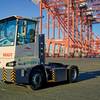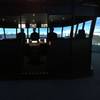In the fourth century B.C., a Greek merchant ship sank off Chios and the Oinoussai islands in the eastern Aegean Sea. The wooden vessel may have succumbed to storm, fire or rough weather, ruining the cargo of 400 ceramic jars of wine and olive oil. The ship went down in 60 meters of water where it remained unnoticed for centuries. The classical-era ship might never have divulged to archaeologists its clues to ancient Greek culture but for a research team from MIT, the Woods Hole Oceanographic Institute (WHOI), the Greek Ministry of Culture and the Hellenic Center for Marine Research (HCMR), who used a novel autonomous underwater vehicle (AUV) to make a high-precision photometric survey of the site last July.
The robotic vehicle used at Chios is an AUV called SeaBed. The AUV scanned the scattered cargo and created a topographical sonar map. WHOI archaeologists and engineers are assembling the 7650 images into mosaics that depict the minute features of the shipwreck. The Chios wreck is playing a critical role in exploring how advanced technology can dramatically change the field of underwater archaeology. The researchers have now released a few photographs showing detailed images of some of the remnants of cargo lying on the ocean floor, where it’s been since about 350 B.C. The researchers took more than 7,000 images, which will eventually be combined into one mosaic of the entire wreck. The new research project will last 10 years or more, focusing on uncovering evidence of ancient trade in the Mediterranean, particularly of the Minoan and Mycenaean cultures and their trading partners in the Bronze Age (2500-1200 B.C.). (Source: http://www.newindpress.com)
Sponsored Content
Innovative Hull Maintenance: Profitable & Green

Subscribe for
Maritime Reporter E-News
Maritime Reporter E-News is the maritime industry's largest circulation and most authoritative ENews Service, delivered to your Email five times per week













